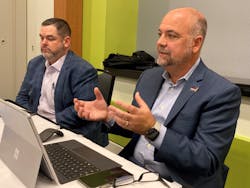Trucking is short 80,000 drivers, here’s why
Nashville—Trucking has a demographics problem, according to Bob Costello, chief economist for American Trucking Associations (ATA). That problem and a mixed bag of other traditional issues that long-haul drivers face over the road have merged with COVID-induced bottlenecks to create a shortage of roughly 80,000 truck drivers this year. That's up from 60,000 in 2018.
To haul interstate freight, commercial truck drivers must be at least 21 years old, but the problem, Costello noted, is that most people don’t wait until they are 21 to get into a trade. So, they go into another career first and consider truck driving later, he said.
“The truck driver training schools say the average age is 35 to get trained,” Costello said during a press conference at ATA’s 2021 Management Conference & Exhibition (MCE) in Nashville. “That pushes our entire age up."
“For-hire truckload will be the lowest age bracket, but they are still in the high 40s,” Costello added. “LTL and private fleets are over 50 years old, which means we have a lot of retirements in this industry. That’s a big problem.”
Another demographics problem: Women make up 47% of the overall workforce in the U.S., but they are not even 8% of all drivers.
ATA first started documenting the driver shortage in 2005, and Costello said these demographics trends were true then and remain true today. However, some new factors have exacerbated the shortage.
When the pandemic hit the U.S. in March 2020, truck driving schools and state commercial licensing agencies reported they trained and awarded CDLs to significantly fewer drivers last year than they did in a normal year, Costello said.
Some were down 60%, some were down 40%, but it’s somewhere in that area, and that was a hole we sort of got dug into because we weren’t able to train enough drivers last year,” he explained. “That makes the shortage even larger.”
Not related to the pandemic, the federal Drug & Alcohol Clearinghouse and wider acceptance and legalization of marijuana contributed to the driver shortage.
“Let me be very clear, ATA is 100% supportive of the Drug & Alcohol Clearinghouse,” Costello said. “If you look at the numbers from FMCSA, we’ve got roughly 70,000 drivers that have tested positive and are at prohibitive status. The vast majority of them aren’t even attempting the return-to-duty process.”
Inadequate infrastructure and a lack of available truck parking also have deeply impacted the driver shortage, Costello said.
Chances of a 160,000-driver shortage
The driver shortage fell a bit in 2019, when freight was softer in some sectors, before climbing again last year. Before the pandemic struck, Costello said the industry actually was attracting new drivers. The problem is, the industry didn't attract enough.
Over the next decade, at current trends, Costello warned that the driver shortage could hit 160,000.
“This is a warning to the entire supply chain—to the motor carriers, to the shippers, everybody—that if things do not change when you look at demographics, it’s essentially taking the trendline of today and projecting it out,” Costello said. “We still aren’t doing very well with females, and we are still older. I really do think the supply chain problems of today are a glimpse into our future if we do not fix this.”
Costello added that the current supply chain problems could be solely caused by a truck driver shortage if trends don’t change.
Part of the problem, Costello pointed out, is that there isn't one reason for the driver shortage, so there is no one solution to fix it.
“Any time you have a situation where demand outstrips supply, price goes up. It is no different in the driver market,” Costello explained.
“One would say you just have to pay them more,” he added. “You absolutely do have to pay them more, because it’s simple supply and demand, but pay alone does not solve this problem. We hear over and over that many drivers want to be home more often. Lifestyle is becoming a bigger issue for this occupation because truckload and LTL employment of local drivers is up. Long haul is essentially flat after falling early in the pandemic, but local trucking jobs are up. I think that’s very telling.”
Local trucking jobs are booming due to spikes in ecommerce, but those opportunities are hurting the recruitment of long-haul drivers. The bulk of the problem, Costello added, is in the over-the-road for-hire truckload space.
Costello also emphasized the importance of looking at the DRIVE-Safe Act and what is in the bipartisan infrastructure bill to help get more 18- and 19-year-olds commercial truck training.
“Over the next 10 years we have to attract just under 1 million people who are not driving today,” Costello said. “The No. 1 reason is because of the retirement of existing drivers. It is also because of people leaving the industry due to lifestyle—they didn’t like it—or people being pushed out due to failed drug tests, driving records, and industry growth. We have to figure out how to get a lot of people into this occupation over the next 10 years.”
Costello added that shippers also are part of the solution to reduce the churn of commercial truck drivers.
“The trucking industry alone cannot solve this,” he stressed. “If you turn drivers around faster, over the course of a year, if every shipper did that and lowered those waiting times, current existing drivers could haul more freight, which means you increase effective capacity without adding one truck to the road. I think that is absolutely part of the solution.”
Within the industry, driver turnover remains quite high—at about 90%, Costello said, noting that the all-time high was 136% in 2005. Most of that turnover is churning in the industry, he added. That’s because as the driver shortage gets more acute, fleets aggressively go out and begin poaching drivers from each other, which increases turnover.
“I will never understand how people can say there’s not a shortage,” Costello said. “Talk to any fleet and they will tell you there is a shortage."
“Shippers can help—turn these drivers around as fast as possible,” he added. “Delivery windows and the supply chain is tough right now, so if a driver misses a delivery window for no reason of their own and they show up after that, don’t make them go to the end of the line. If you have an opening come up, let that driver go in. There are a lot of things that can happen. Fleets are part of the solution, government is part of the solution, and shippers are part of the solution as well.”
This article originally appeared on FleetOwner.
About the Author
Cristina Commendatore
Cristina Commendatore is the Executive Editor of FleetOwner magazine. She has reported on the transportation industry since 2015, covering topics such as business operational challenges, driver and technician shortages, truck safety, and new vehicle technologies. She holds a master’s degree in journalism from Quinnipiac University in Hamden, Conn.


